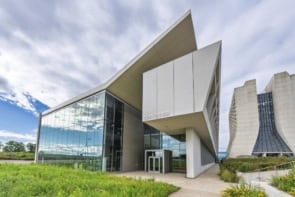
Physicists at the Tokai-to-Kamioka (T2K) in Japan are celebrating the first detection of neutrinos in what is set to be one of the world’s largest facilities for studying these subatomic particles.
The researchers successfully fired a beam of neutrinos from the 50 GeV synchrotron at the $1.5bn Japan Proton Accelerator Research Complex (J-PARC), which is based in Tokai on the east coast of Japan, at the so-called near detector, which lies 200 m away from the main ring. Researchers expect to have a full neutrino beam sometime in January, with the first results from T2K expected in a year’s time.
Neutrinos are generated at J-PARC by firing high-energy protons at a graphite target. This produces pions, which decay into muons – heavier cousins of the electron – and muon neutrinos. After passing through the near detector, which characterizes the neutrino beam, the muon neutrinos are then sent to the vast SuperKamiokande detector, in Hida, some 300 km north-west from Tokai on Japan’s west coast.
50,000 tonnes of water
Neutrinos interact very weakly with matter, which is why the SuperKamiokande detector consists of 11,146 photomultiplier tubes, each 50 cm in diameter, and 50,000 tonnes of water. The photomultiplier tubes pick up the radiation emitted when a neutrino interacts with a water molecule.
Neutrinos exist in three “flavours” – muon, electron and tau – that oscillate from one to the other as they travel in space. Researchers at J-PARC will be attempting to measure the oscillation from muon neutrino to electron neutrino – the final “mixing angle” yet to be measured, known as theta-13.
J-PARC produced its first muons from the graphite target in September 2007. While it may have also created muon neutrinos, they were not detected because the near detector was still being built and the proton beam not intense enough.
It was extremely satisfying to see the first events in the detector Dave Wark, Imperial College London
Now researchers at J-PARC have ramped up the energy of the proton beam to around 100 kW – enough power to be able to produce a beam of muon neutrinos. “It was extremely satisfying to see the first events in the detector,” says Dave Wark of Imperial College London and international co-spokesperson for T2K.
Although the sake was flowing as physicists celebrated, Wark told physicsworld.com that there is still a lot of work to do such as tuning the beam and increasing the proton intensity to get a larger neutrino flux. “I think we will have a sake or two to celebrate and then send a bottle along to [the CERN particle-physics lab near Geneva] as I hear they are going to need quite a few bottles pretty soon as well,” says Wark.
Scientists at J-PARC will also soon start to commission the on-axis near detector, which will allow researchers to characterize the neutrino beam’s energy distribution and intensity before it is sent to the SuperKamiokande detector. “SuperKamiokande has been set up beautifully and is well ready,” says Wark.



